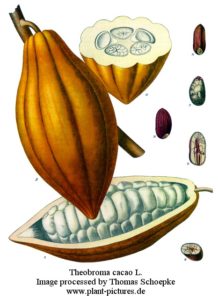What we call Chocolate is also known as Theobroma cacao. The botanical name “theobroma” means “food of the gods”; it was given to the plant by Europeans during their overseas scientific expeditions of the 1700s. They endeavored to classify all plant matter on earth and thus both a genus and a species name was assigned to each plant. Carl Linneaus, a Swedish botanist who lived during the 1700s theorized that a naming convention would eliminate confusion among the hundreds of thousands of plants known at the time to exist.

Isn’t the gold color of the seed pod of the chocolate tree captivating, enchanting? To think of the ancient Olmec tribes frolicking with cups of chocolate pod pulp, perhaps an occasional chocolate drink, brings the history of hundreds of years into the present. For who doesn’t like chocolate surely enjoys a good tale about it and shares the appeal that spices and condiments, sauces and spreads add to our tables.
It’s delightful that chocolate begets so many forms of chocolate: drinks, sauces, confections and cakes, enriched by the addition of nuts, coffee, spices and even chiles. Maricel E. Presilla is a Latin American Food Historian who’s several restaurants offer Cuban and South American food. She is a well-known expert in chocolate, how and where it’s grown, how and where it’s produced as edible, how it should be prepared in recipes. Presilla’s recipes are the delicious finale to her treatise on chocolate, a natural history of the food of the gods! In this last section of her book, The New Taste of Chocolate: A Cultural and Natural History of Cacao with Recipes, by Maricel E. Presilla, the variety of hot chocolate… More…



